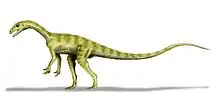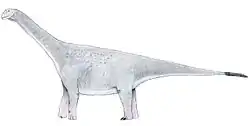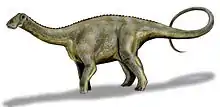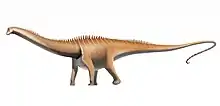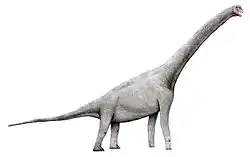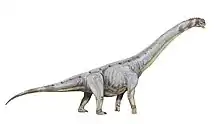Mussaurus
Mussaurus (meaning "mouse lizard") is a genus of herbivorous sauropodomorph dinosaur that lived in southern Argentina during the Late Triassic, about 215 million years ago. It receives its name from the small size of the skeletons of juvenile and infant individuals, which were once the only known specimens of the genus. However, since Mussaurus is now known from adult specimens,[1] the name is something of a misnomer; adults possibly reached 6 metres (20 ft) in length and weighed more than 1,000 kilograms (2,200 lb).[2] Mussaurus possesses anatomical features suggesting a close, possibly transitional evolutionary relationship with true sauropods.[3]
| Mussaurus | |
|---|---|
 | |
| Fossil juvenile skeleton | |
| Scientific classification | |
| Kingdom: | Animalia |
| Phylum: | Chordata |
| Clade: | Dinosauria |
| Clade: | Saurischia |
| Suborder: | †Sauropodomorpha |
| Family: | †Mussauridae Bonaparte & Vince, 1979 |
| Genus: | †Mussaurus Bonaparte & Vince, 1979 |
| Type species | |
| †Mussaurus patagonicus Bonaparte & Vince, 1979 | |
Discovery
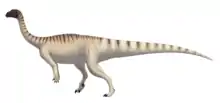
Infant and juvenile fossils of Mussaurus were first discovered by an expedition led by Jose Bonaparte during the 1970s to the Laguna Colorada Formation.[3] There the team found fossilized eggs and hatchlings, which added insight into the reproductive strategies of Mussaurus and other sauropodomorph dinosaurs.[3] The first adult specimens of Mussaurus were described in 2013. Some of these specimens had first been described in 1980 and were originally attributed to the genus Plateosaurus.[1]
Phylogeny
Previous to the discovery of adult specimens of Mussaurus, the phylogenetic position of this taxon was difficult to establish. Infant and juvenile fossils are known to show more basal traits than adult specimens of the same taxon. Furthermore, the recently discovered one subadult and three adult specimens assigned to Mussaurus are more complete than other material assigned to it. Therefore, a cladistic analysis of basal sauropodomorphs performed by Otero and Pol (2013) to test the phylogenetic relationships of Mussaurus, included information only from adult specimens. The following cladogram is simplified after their analysis (relationships outside Plateosauria are not shown).[1]
| Plateosauria |
| ||||||||||||||||||||||||||||||||||||||||||||||||||||||||||||||||||||||||||||||||||||||||||||||||||||||||||||||||||||||||||||||||||||||||||||||||||||||||||||||||||||||||||||||||||||||||||||||||||||||||||||
Palaeobiology
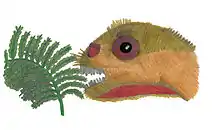
Reproduction
Mussaurus specimens have been found in association with nests that are believed to contain multiple eggs apiece. The skeletons of Mussaurus infants were small, only six inches long excluding the tail, but a total of 20 to 37 centimetres (7.9 to 14.6 in) long. This is about the size of a small lizard. Juveniles differed from adults in proportion in addition to size and mass. As is common for dinosaurs, juvenile Mussaurus had tall skulls with short snouts and large eyes.[3]
These proportions are common in many infant vertebrates and are often associated with species that provide parental care during the vulnerable early stages of life. Adults are expected to have longer snouts and necks, as typical in early sauropodomorphs.
Locomotion
A study published in May 2019 shows that while M. patagonicus probably walked on all four limbs (was quadrupedal) during the first year of its life, changes in the relative proportions of its body during growth (ontogeny) caused its centre of mass to move backwards towards its pelvis, resulting in the animal adopting a two-legged (bipedal) stance later in life.[2][4]
References
- Otero, A.; Pol, D. (2013). "Postcranial anatomy and phylogenetic relationships of Mussaurus patagonicus (Dinosauria, Sauropodomorpha)". Journal of Vertebrate Paleontology. 33 (5): 1138. doi:10.1080/02724634.2013.769444.
- Otero, Alejandro; Cuff, Andrew R.; Allen, Vivian; Sumner-Rooney, Lauren; Pol, Diego; Hutchinson, John R. (2019-05-20). "Ontogenetic changes in the body plan of the sauropodomorph dinosaur Mussaurus patagonicus reveal shifts of locomotor stance during growth". Scientific Reports. Springer Science and Business Media LLC. 9 (1): 7614. doi:10.1038/s41598-019-44037-1. ISSN 2045-2322. PMC 6527699. PMID 31110190.
- "Mussaurus." In: Dodson, Peter & Britt, Brooks & Carpenter, Kenneth & Forster, Catherine A. & Gillette, David D. & Norell, Mark A. & Olshevsky, George & Parrish, J. Michael & Weishampel, David B. The Age of Dinosaurs. Publications International, LTD. p. 40. ISBN 0-7853-0443-6.
- Geggel, Laura (2019-05-28). "No, That Baby Dinosaur Didn't Crawl. But It Did Walk on 4 Legs As an Infant". Live Science. Retrieved 2019-05-28.
Further reading
- Bonaparte, J. F.; Vince, M. (1979). "El hallazgo del primer nido de dinosaurios triasicos, (Saurischia, Prosauropoda), Triasico Superior de Patagonia, Argentina [The discovery of the first nest of Triassic dinosaurs (Saurischia, Prosauropoda,) from the Upper Triassic of Patagonia, Argentina]". Ameghiniana. 16 (1–2): 173–182.
- Pol, D.; Powell, J. E. (2007). "Skull anatomy of Mussaurus patagonicus (Dinosauria: Sauropodomorpha) from the Late Triassic of Patagonia". Historical Biology. 19 (1): 125–144. doi:10.1080/08912960601140085.
